Effect of Mud Powder on the Performance of Bridge Deck Leveling Concrete in a Seasonally Frozen Region
Abstract
:1. Introduction
2. Materials and Methods
2.1. Materials and Mix Designs
2.2. Specimen Preparation and Curing
2.3. Mechanical Properties Tests
2.4. Rapid Chloride Permeability Test
2.5. Freeze–Thaw Test
- (a)
- Mass loss rate exceeding 5%
- (b)
- Relative dynamic modulus of elasticity declining to less than 60%
2.6. Microhardness Test
3. Results and Discussion
3.1. Mechanical Properties
3.1.1. Compressive Strength and Static Compressive Elastic Modulus
3.1.2. Splitting Tensile Strength and Flexural-Tensile Strength
3.1.3. Bond Strength
3.2. Durability
3.2.1. Chloride Ion Penetration Resistance
3.2.2. Frost Resistance
Freeze–Thaw Cycle
Coupling of Salt Solution and Freeze–Thaw Cycle
3.3. Properties of ITZ
4. Conclusions
- (1)
- In the initial stages of curing, concrete without mud powder in aggregates demonstrates superior performance in terms of compressive strength, static compressive elastic modulus, and splitting tensile bond strength. However, the compressive strength and static compressive elastic modulus of the concrete with mud powder surpass those of the concrete without mud powder at the 14 days and 28 days.
- (2)
- During the curing period spanning from 7 days to 28 days, the inclusion of mud powder in the aggregate resulted in a reduction of both the splitting tensile strength and flexural-tensile strength of the concrete. Interestingly, there was a notable positive correlation between the splitting tensile strength and bending tensile strength of the concrete.
- (3)
- Concrete without mud powder demonstrates better resistance to chloride ion penetration, whereas the chloride ion penetration resistance of concrete containing clay powder is lower compared to that of concrete containing mud powder in river sands and coarse aggregate.
- (4)
- The presence of mud powder in aggregates diminishes the early-stage frost resistance of concrete, with clay powder leading to a more substantial reduction in frost resistance compared to mud powder derived from river sands and coarse aggregates. Furthermore, the coupling of salt solution and freeze–thaw cycles significantly intensifies the extent of freeze–thaw damage in comparison to freeze–thaw cycles in water only.
- (5)
- The compressive strength of bridge deck leveling concrete (BDLC) typically fulfills the structural demands for bridge construction. However, the tensile characteristics and durability predominantly influence the service life of BDLC. While mud powder does contribute to the increased compressive strength of concrete in the later stages, its presence in the aggregates results in reduced tensile properties and diminished durability of BDLC. As a result, it is crucial to minimize the mud powder content in the aggregates, considering the various compositions of mud powder and the specific operational conditions of BDLC in regions subject to seasonal freezing.
- (6)
- No significant correlation was observed between the ITZ and compressive strength or static compressive elastic modulus. However, a clear relationship was established between the properties of the ITZ and tensile characteristics and durability. Further research is required to fully understand the nature and characteristics of the ITZ.
Author Contributions
Funding
Institutional Review Board Statement
Informed Consent Statement
Data Availability Statement
Acknowledgments
Conflicts of Interest
References
- Huang, X. A review of the current status of research on asphalt paving layer technology for cement concrete bridge decks. J. Transp. Eng. 2014, 14, 1–10. [Google Scholar]
- Aaleti, S.; Sritharan, S. Quantifying bonding characteristics between UHPC and normal-strength concrete for bridge deck application. J. Bridge Eng. 2019, 24, 04019041. [Google Scholar] [CrossRef]
- Ren, D.; Shang, J.; Xu, J.; Huang, M.; Chen, X.; Cao, C.; Ai, C. Detection and quantitative evaluation of pumping distress on bridge deck pavement through field and laboratory experiments. Constr. Build. Mater. 2023, 378, 131208. [Google Scholar] [CrossRef]
- Haynes, M.A.; Coleri, E.; Obaid, I. Performance of Waterproofing Membranes to Protect Concrete Bridge Decks. Transp. Res. Rec. 2021, 2675, 1693–1706. [Google Scholar] [CrossRef]
- Wang, G.; Xie, X.; Wang, C.; Shen, Y. Stress performance of simply supported girder bridge with arch-type deck continuous structure. J. Zhejiang Univ. (Eng. Sci.) 2014, 48, 1049–1057. [Google Scholar] [CrossRef]
- Zhang, H.; Gao, P.; Zhang, Z.; Pan, Y. Experimental study of the performance of a stress-absorbing waterproof layer for use in asphalt pavements on bridge decks. Constr. Build. Mater. 2020, 254, 119290. [Google Scholar] [CrossRef]
- Zang, J.; Pan, Z.; Luo, J.; Wang, P. Influence of overloading and leveling layer thickness on the force of continuous rigid bridge deck pavement. J. Chongqing Jiaotong Univ. Nat. Sci. Ed. 2013, 32, 1137–1140. [Google Scholar]
- Mehta, P.K.; Monteiro, P.J. Concrete: Microstructure, Properties, and Materials; McGraw-Hill Education: New York, NY, USA, 2014. [Google Scholar]
- Neville, A.M. Properties of Concrete; Longman: London, UK, 1995; Volume 4. [Google Scholar]
- Zhang, P.; Wittmann, F.H.; Vogel, M.; Müller, H.S.; Zhao, T. Influence of freeze-thaw cycles on capillary absorption and chloride penetration into concrete. Cem. Concr. Res. 2017, 100, 60–67. [Google Scholar] [CrossRef]
- Zeng, Q.; Li, K. Effect of cooling rate on deformation and damage of cementitious materials under freeze-thaw conditions. J. Tsinghua Univ. Nat. Sci. Ed. 2008, 48, 1390–1394. [Google Scholar]
- Şahin, Y.; Akkaya, Y.; Taşdemir, M.A. Effects of freezing conditions on the frost resistance and microstructure of concrete. Constr. Build. Mater. 2021, 270, 121458. [Google Scholar] [CrossRef]
- Qiao, C.; Chen, X.; Suraneni, P.; Weiss, W.J.; Rothstein, D. Petrographic analysis of in-service cementitious mortar subject to freeze-thaw cycles and deicers. Cem. Concr. Compos. 2021, 122, 104112. [Google Scholar] [CrossRef]
- Wang, R.; Zhang, Q.; Li, Y. Deterioration of concrete under the coupling effects of freeze–thaw cycles and other actions: A review. Constr. Build. Mater. 2022, 319, 126045. [Google Scholar] [CrossRef]
- Pigeon, M.; Marchand, J.; Pleau, R. Frost resistant concrete. Constr. Build. Mater. 1996, 10, 339–348. [Google Scholar] [CrossRef]
- Li, B.; Mao, J.; Nawa, T.; Liu, Z. Mesoscopic chloride ion diffusion model of marine concrete subjected to freeze-thaw cycles. Constr. Build. Mater. 2016, 125, 337–351. [Google Scholar] [CrossRef]
- Mu, R.; Miao, C.; Luo, X.; Sun, W. Interaction between loading, freeze–thaw cycles, and chloride salt attack of concrete with and without steel fiber reinforcement. Cem. Concr. Res. 2002, 32, 1061–1066. [Google Scholar] [CrossRef]
- Angst, U.M.; Elsener, B.; Larsen, C.K.; Vennesland, Ø. Chloride induced reinforcement corrosion: Electrochemical monitoring of initiation stage and chloride threshold values. Corros. Sci. 2011, 53, 1451–1464. [Google Scholar] [CrossRef]
- Tang, Y.; Zuo, Y.; Wang, J.; Zhao, X.; Niu, B.; Lin, B. The metastable pitting potential and its relation to the pitting potential for four materials in chloride solutions. Corros. Sci. 2014, 80, 111–119. [Google Scholar] [CrossRef]
- Bentur, A.; Berke, N.; Diamond, S. Steel Corrosion in Concrete: Fundamentals and Civil Engineering Practice; CRC Press: Boca Raton, FL, USA, 1997. [Google Scholar]
- Zhang, P.; Cong, Y.; Vogel, M.; Liu, Z.; Müller, H.S.; Zhu, Y.; Zhao, T. Steel reinforcement corrosion in concrete under combined actions: The role of freeze-thaw cycles, chloride ingress, and surface impregnation. Constr. Build. Mater. 2017, 148, 113–121. [Google Scholar] [CrossRef]
- Wang, Z.; Zeng, Q.; Wang, L.; Yao, Y.; Li, K. Corrosion of rebar in concrete under cyclic freeze–thaw and Chloride salt action. Constr. Build. Mater. 2014, 53, 40–47. [Google Scholar] [CrossRef]
- GB/T 14684—2022; Sand for Construction. Standards Press of China: Beijing, China, 2022.
- GB/T 14685—2011; Pebble and Crushed Stone for Construction. Standards Press of China: Beijing, China, 2011.
- Tregger, N.A.; Pakula, M.E.; Shah, S.P. Influence of clays on the rheology of cement pastes. Cem. Concr. Res. 2010, 40, 384–391. [Google Scholar] [CrossRef]
- Ma, B.; Yang, H.; Tan, H.; Dai, Z. Adsorption characteristics of cement and clay minerals on different water reducing agents. J. Silic. 2013, 41, 328–333. [Google Scholar]
- Fernandes, V.; Purnell, P.; Still, G.; Thomas, T. The effect of clay content in sands used for cementitious materials in developing countries. Cem. Concr. Res. 2007, 37, 751–758. [Google Scholar] [CrossRef]
- Nilsen, A.U.; Monteiro, P.J. Concrete: A three phase material. Cem. Concr. Res. 1993, 23, 147–151. [Google Scholar] [CrossRef]
- Hashin, Z.; Monteiro, P. An inverse method to determine the elastic properties of the interphase between the aggregate and the cement paste. Cem. Concr. Res. 2002, 32, 1291–1300. [Google Scholar] [CrossRef]
- Lee, K.; Park, J. A numerical model for elastic modulus of concrete considering interfacial transition zone. Cem. Concr. Res. 2008, 38, 396–402. [Google Scholar] [CrossRef]
- Zhang, H.; Ji, T.; Zeng, X.; Yang, Z.; Lin, X.; Liang, Y. Mechanical behavior of ultra-high performance concrete (UHPC) using recycled fine aggregate cured under different conditions and the mechanism based on integrated microstructural parameters. Constr. Build. Mater. 2018, 192, 489–507. [Google Scholar] [CrossRef]
- Diamond, S.; Huang, J. The ITZ in concrete—A different view based on image analysis and SEM observations. Cem. Concr. Compos. 2001, 23, 179–188. [Google Scholar] [CrossRef]
- Zhao, S.; Qiu, H.; Gong, J.; Wang, P. Influence of coarse aggregate mud content on mechanical properties and frost durability of concrete. Highw. Transp. Sci. Technol. Appl. Technol. Ed. 2007, 1, 43–45. [Google Scholar]
- Nehdi, M. Clay in cement-based materials: Critical overview of state-of-the-art. Constr. Build. Mater. 2014, 51, 372–382. [Google Scholar] [CrossRef]
- Hamed, N.; El-Feky, M.; Kohail, M.; Nasr, E.-S.A. Effect of nano-clay de-agglomeration on mechanical properties of concrete. Constr. Build. Mater. 2019, 205, 245–256. [Google Scholar] [CrossRef]
- Ashraf, M.; Iqbal, M.F.; Rauf, M.; Ashraf, M.U.; Ulhaq, A.; Muhammad, H.; Liu, Q.-f. Developing a sustainable concrete incorporating bentonite clay and silica fume: Mechanical and durability performance. J. Clean. Prod. 2022, 337, 130315. [Google Scholar] [CrossRef]
- GB-T 175-2007; Common Portland Cement. Standards Press of China: Beijing, China, 2007.
- GB-T 1596-2017; Fly Ash Used for Cement and Concrete. Standards Press of China: Beijing, China, 2017.
- JTG 3420-2020; Test Methods of Cement and Concrete for Highway Engineering. China Communication Press: Beijing, China, 2020.
- GB/T 50081-2019; Standard for Test Methods of Concrete Physical and Mechanical Properties. China Building Industry Press: Beijing, China, 2019.
- Zhao, Z.; Zhao, G.; Liu, J.; Yu, Y. Experimental study on the tensile properties of new and old concrete bonds. J. Build. Struct. 2001, 22, 51–56. [Google Scholar]
- Santos, P.M.; Julio, E.N. Correlation between concrete-to-concrete bond strength and the roughness of the substrate surface. Constr. Build. Mater. 2007, 21, 1688–1695. [Google Scholar] [CrossRef]
- He, Y.; Zhang, X.; Hooton, R.; Zhang, X. Effects of interface roughness and interface adhesion on new-to-old concrete bonding. Constr. Build. Mater. 2017, 151, 582–590. [Google Scholar] [CrossRef]
- Momayez, A.; Ehsani, M.; Ramezanianpour, A.; Rajaie, H. Comparison of methods for evaluating bond strength between concrete substrate and repair materials. Cem. Concr. Res. 2005, 35, 748–757. [Google Scholar] [CrossRef]
- ASTM C1202; Standard Test Method for Electrical Indication of Concrete’s Ability to Resist Chloride Ion Penetration. ASTM: West Conshohocken, PA, USA, 2022.
- Sun, Z.; Garboczi, E.J.; Shah, S.P. Modeling the elastic properties of concrete composites: Experiment, differential effective medium theory, and numerical simulation. Cem. Concr. Compos. 2007, 29, 22–38. [Google Scholar] [CrossRef]
- Sun, G.; Zhang, Y.; Sun, W.; Liu, Z.; Wang, C. Multi-scale prediction of the effective chloride diffusion coefficient of concrete. Constr. Build. Mater. 2011, 25, 3820–3831. [Google Scholar] [CrossRef]
- Pigeon, M.; Gagne, R.; Foy, C. Critical air-void spacing factors for low water-cement ratio concretes with and without condensed silica fume. Cem. Concr. Res. 1987, 17, 896–906. [Google Scholar] [CrossRef]
- Powers, T.C.; Helmuth, R. Theory of Volume Changes in Hardened Portland-Cement Paste during Freezing. In Proceedings of the Thirty-Second Annual Meeting of the Highway Research Board, Washington, DC, USA, 13–16 January 1953. [Google Scholar]
- Liu, Z.; Hansen, W. Freezing characteristics of air-entrained concrete in the presence of deicing salt. Cem. Concr. Res. 2015, 74, 10–18. [Google Scholar] [CrossRef]
- Yang, Q. Salt freezing damage mechanism of concrete (Ⅱ): Freeze-thaw water saturation and icing pressure. J. Build. Mater. 2012, 15, 741–746. [Google Scholar]

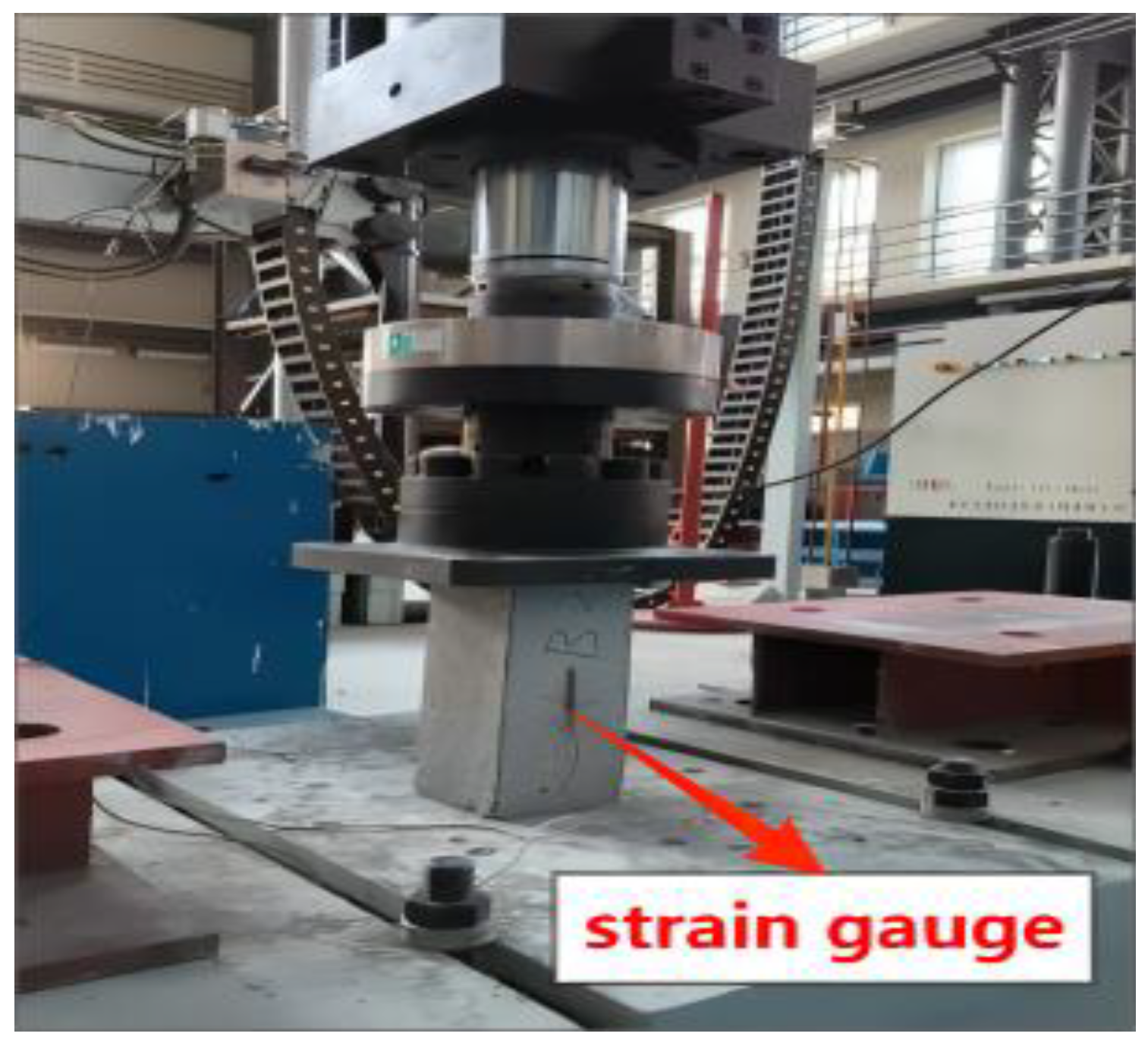

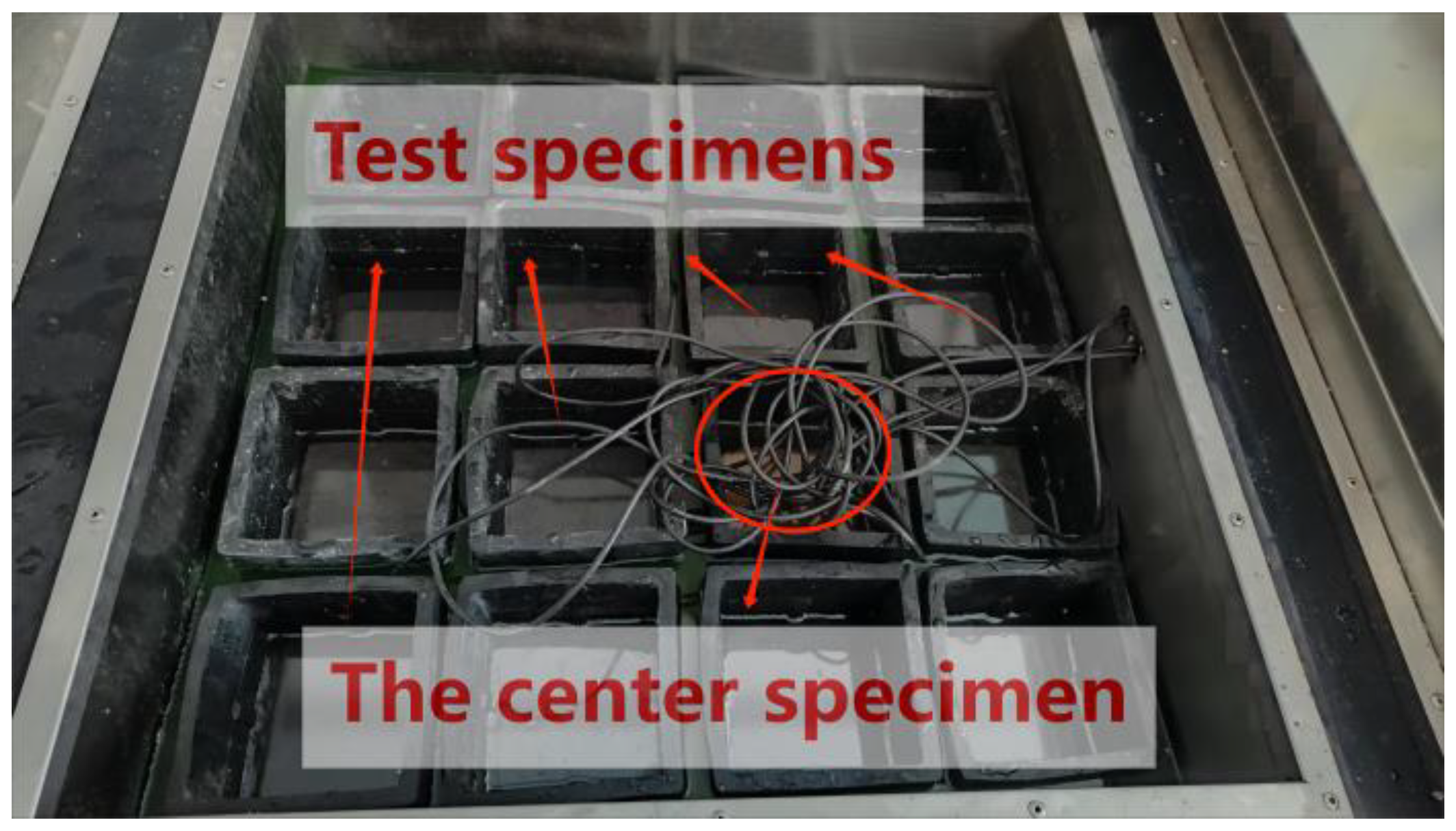
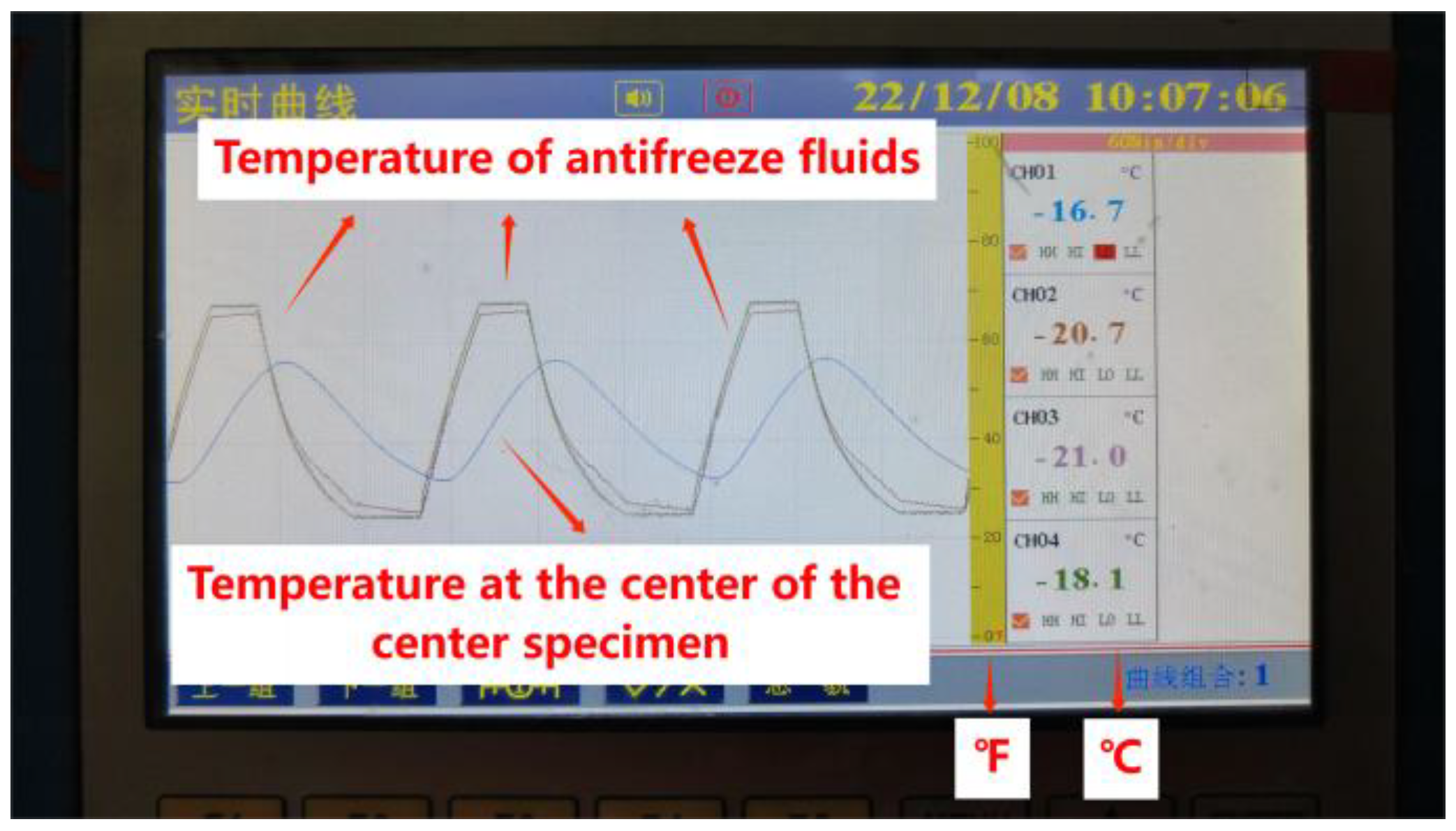

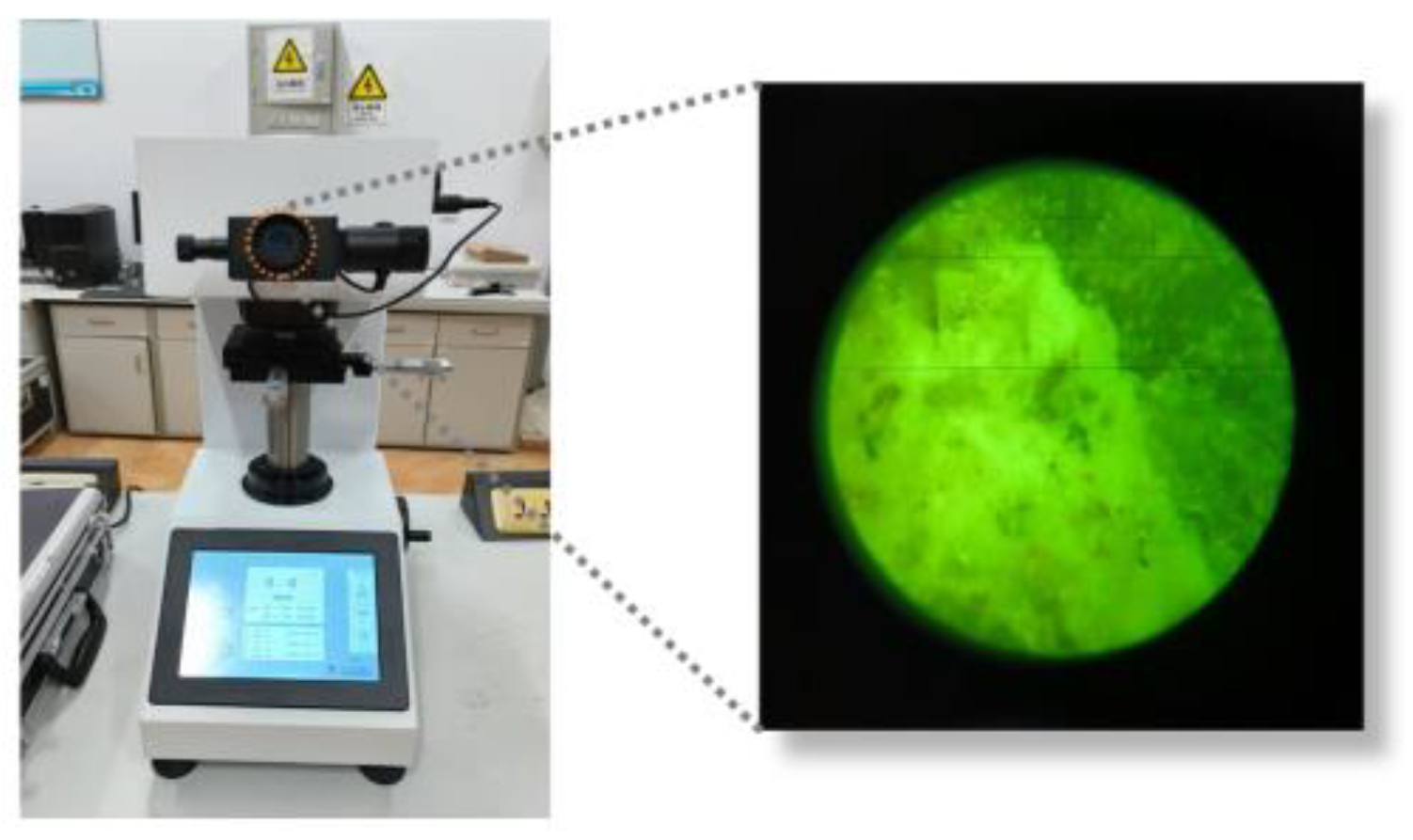
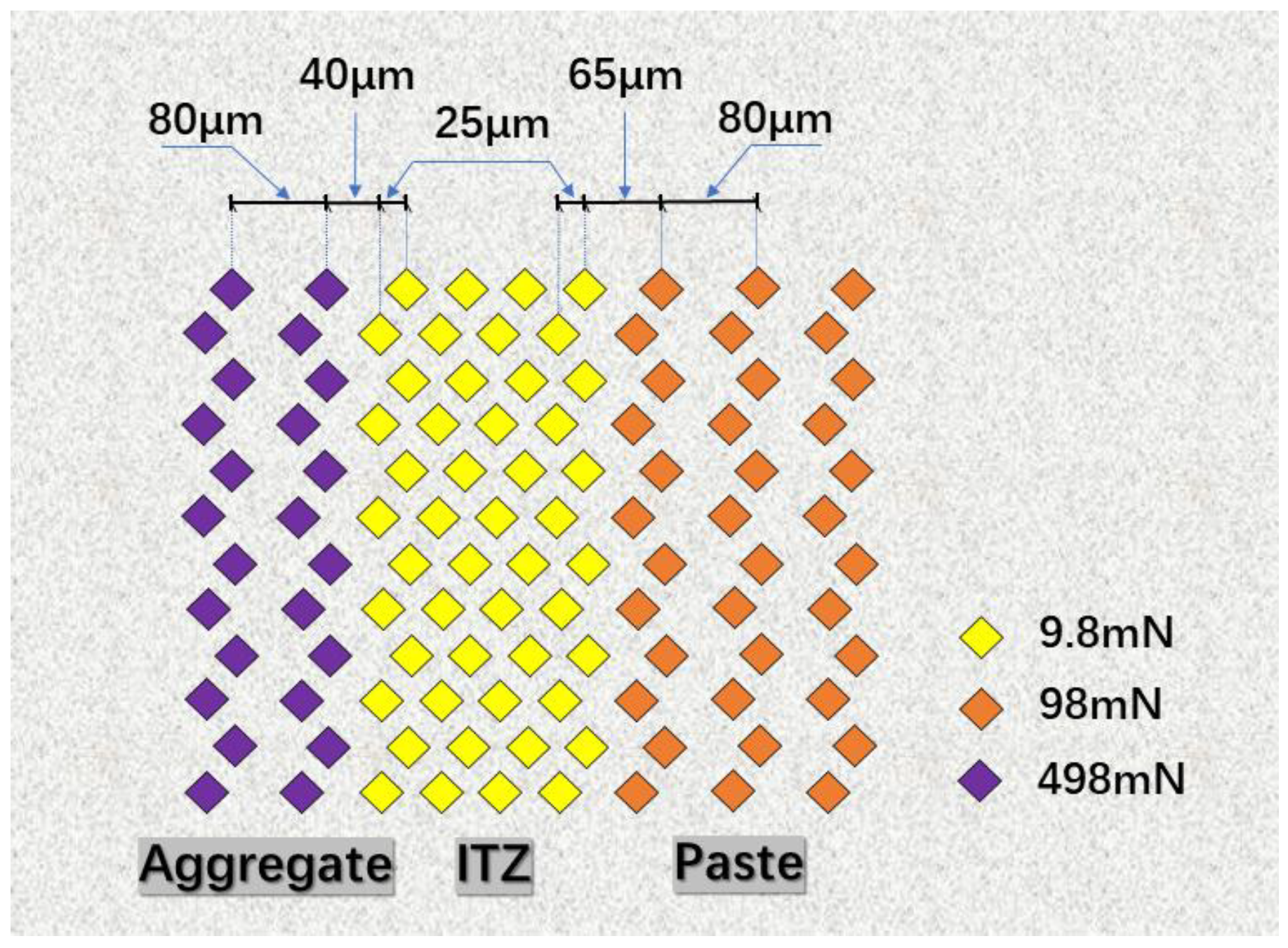
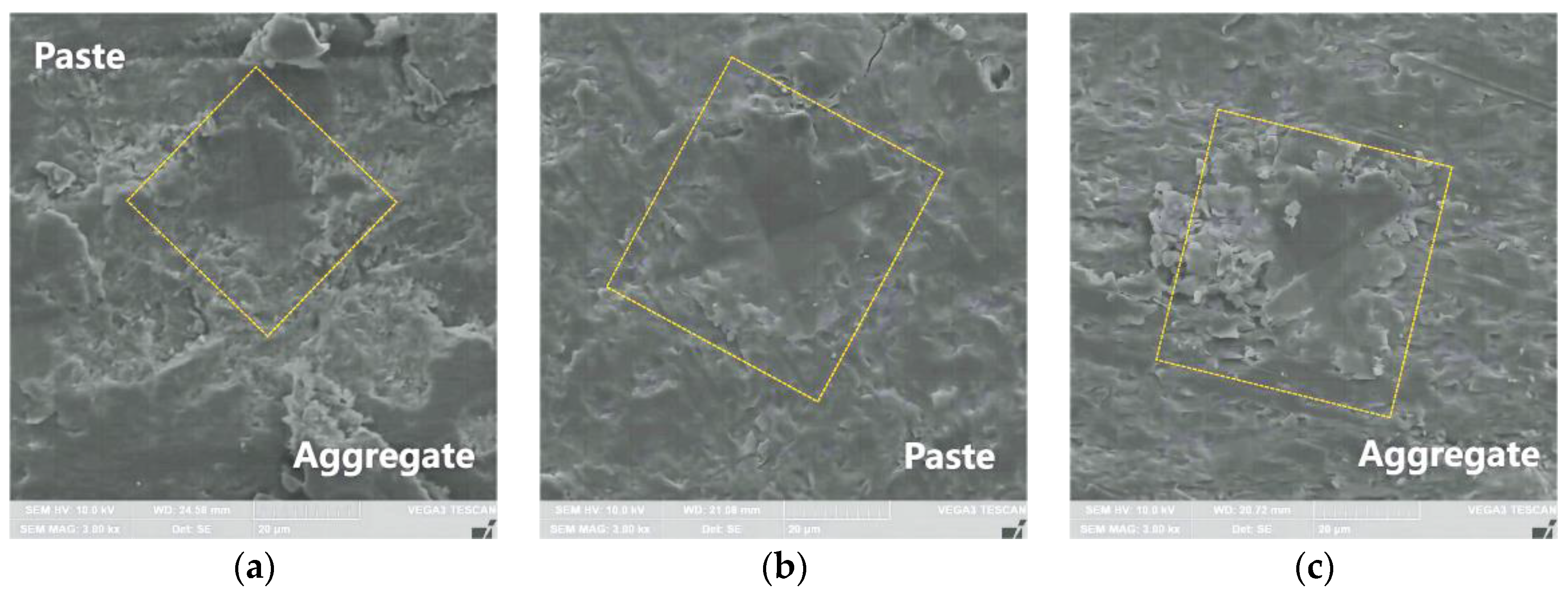
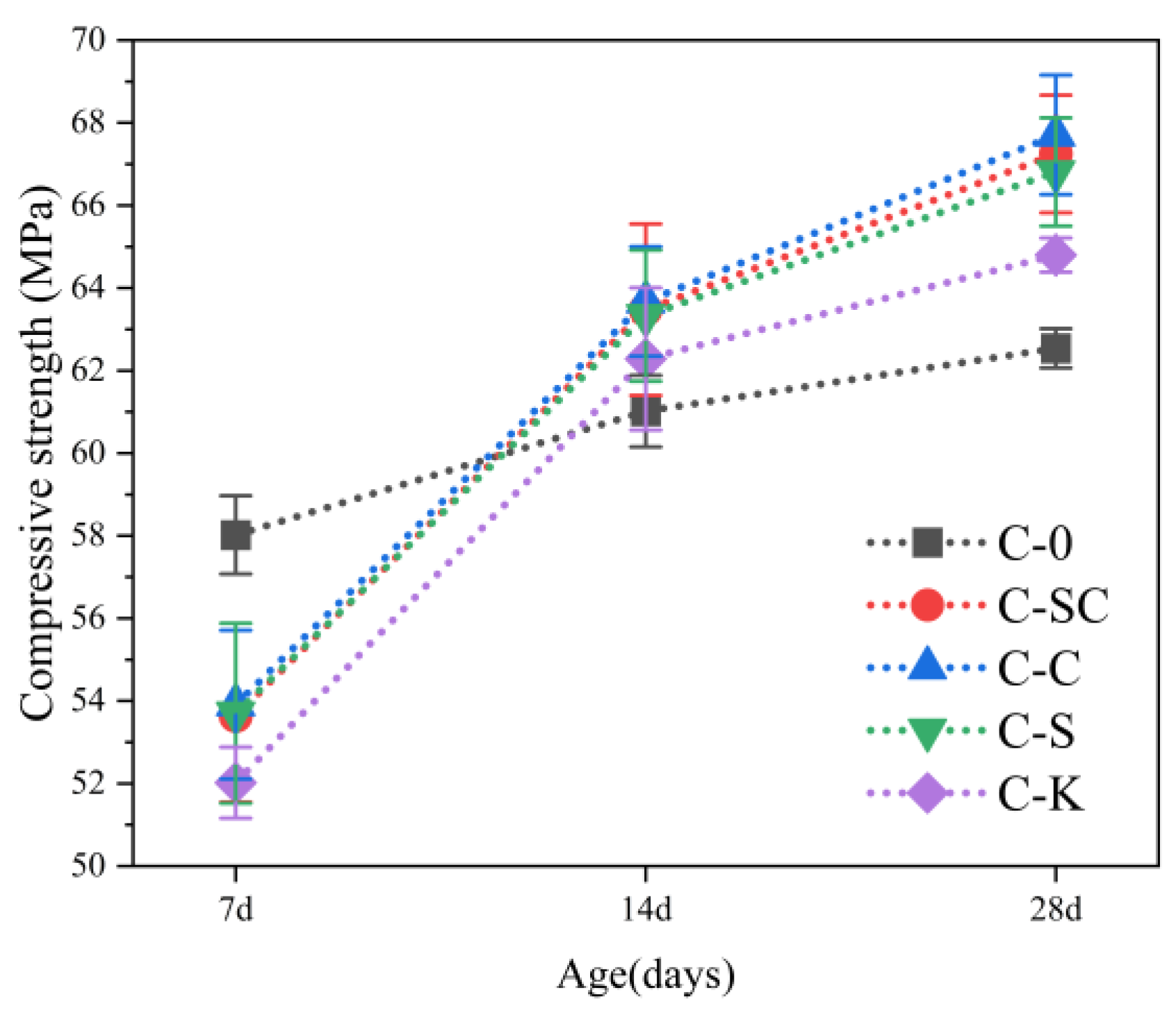

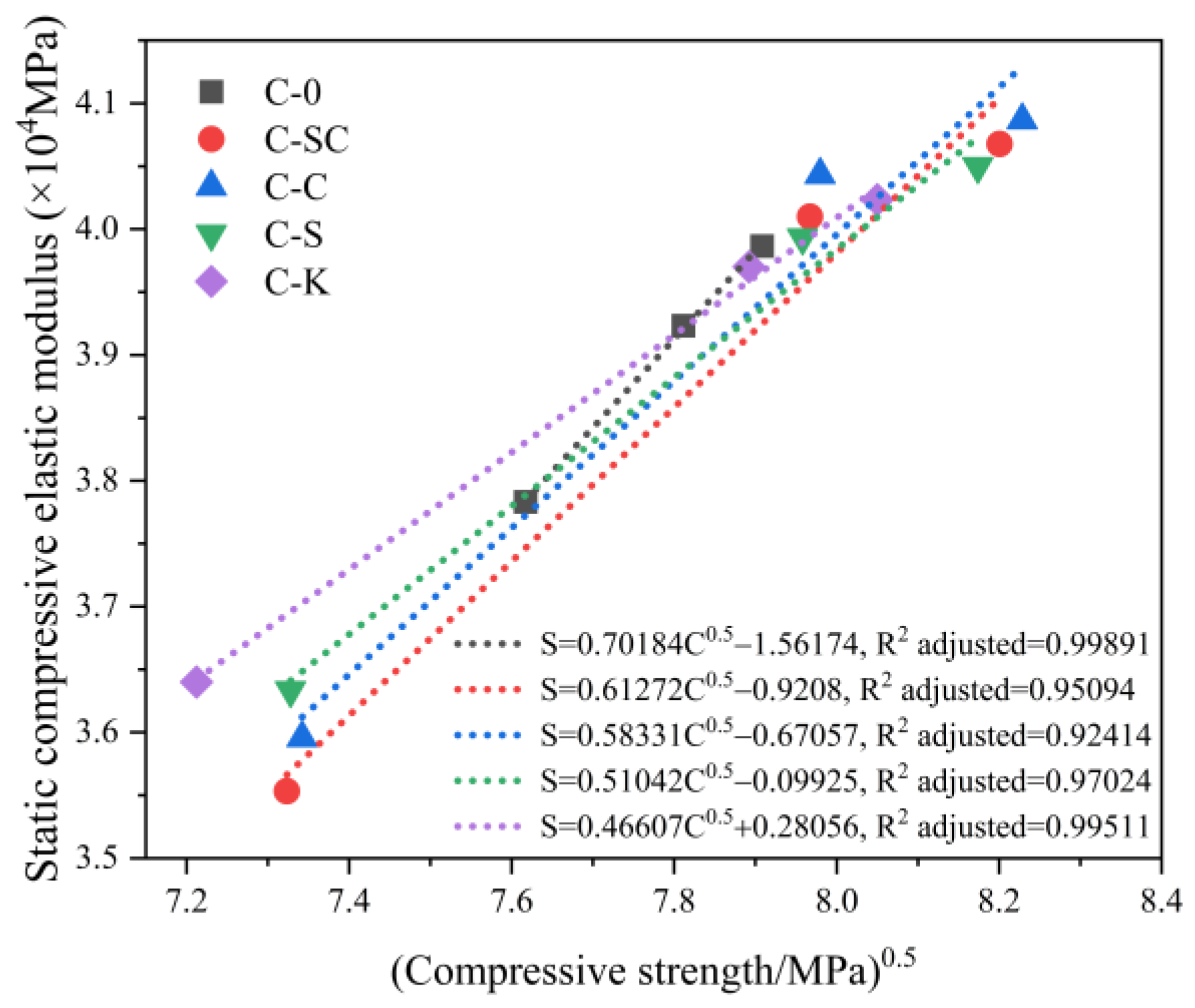
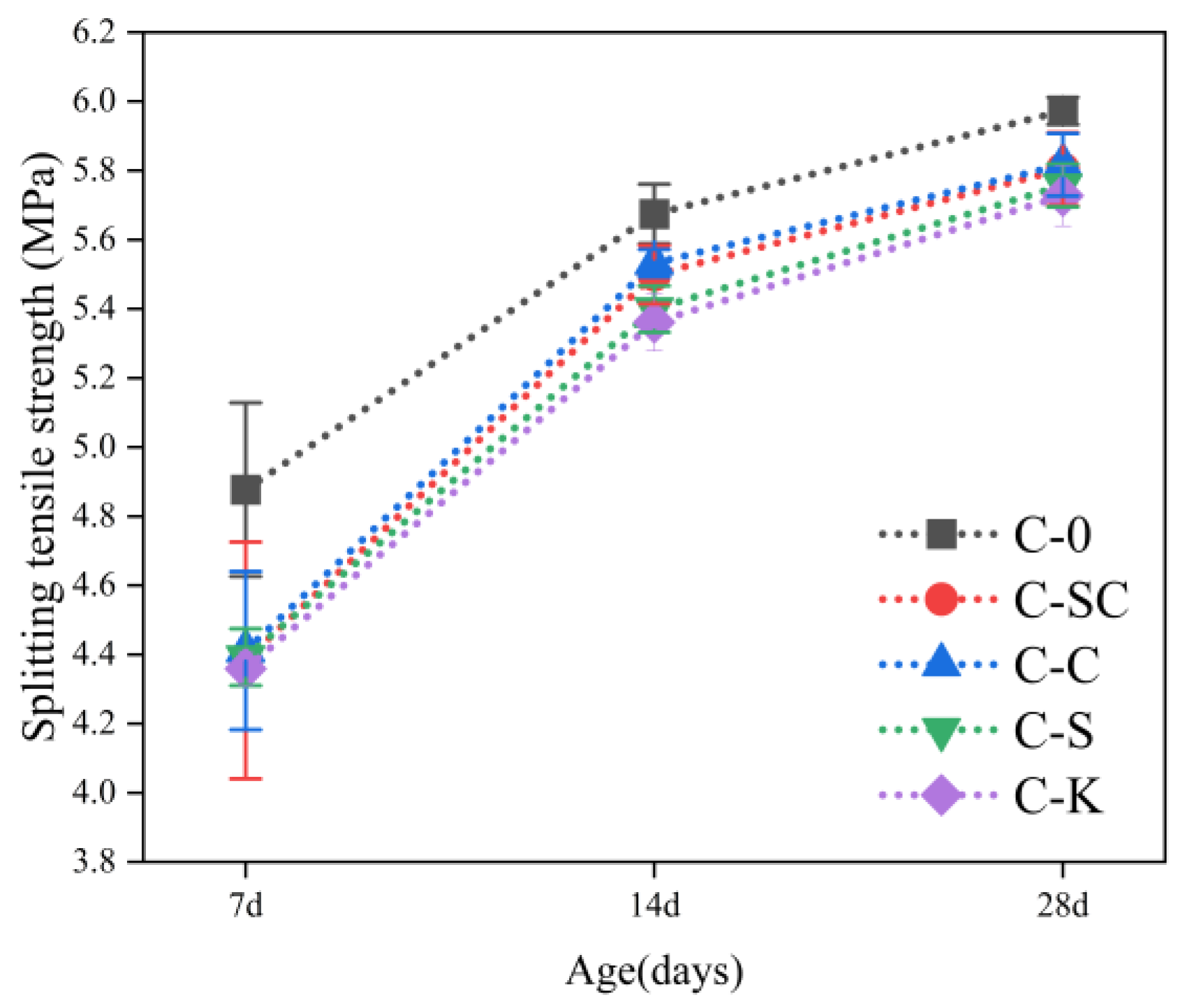
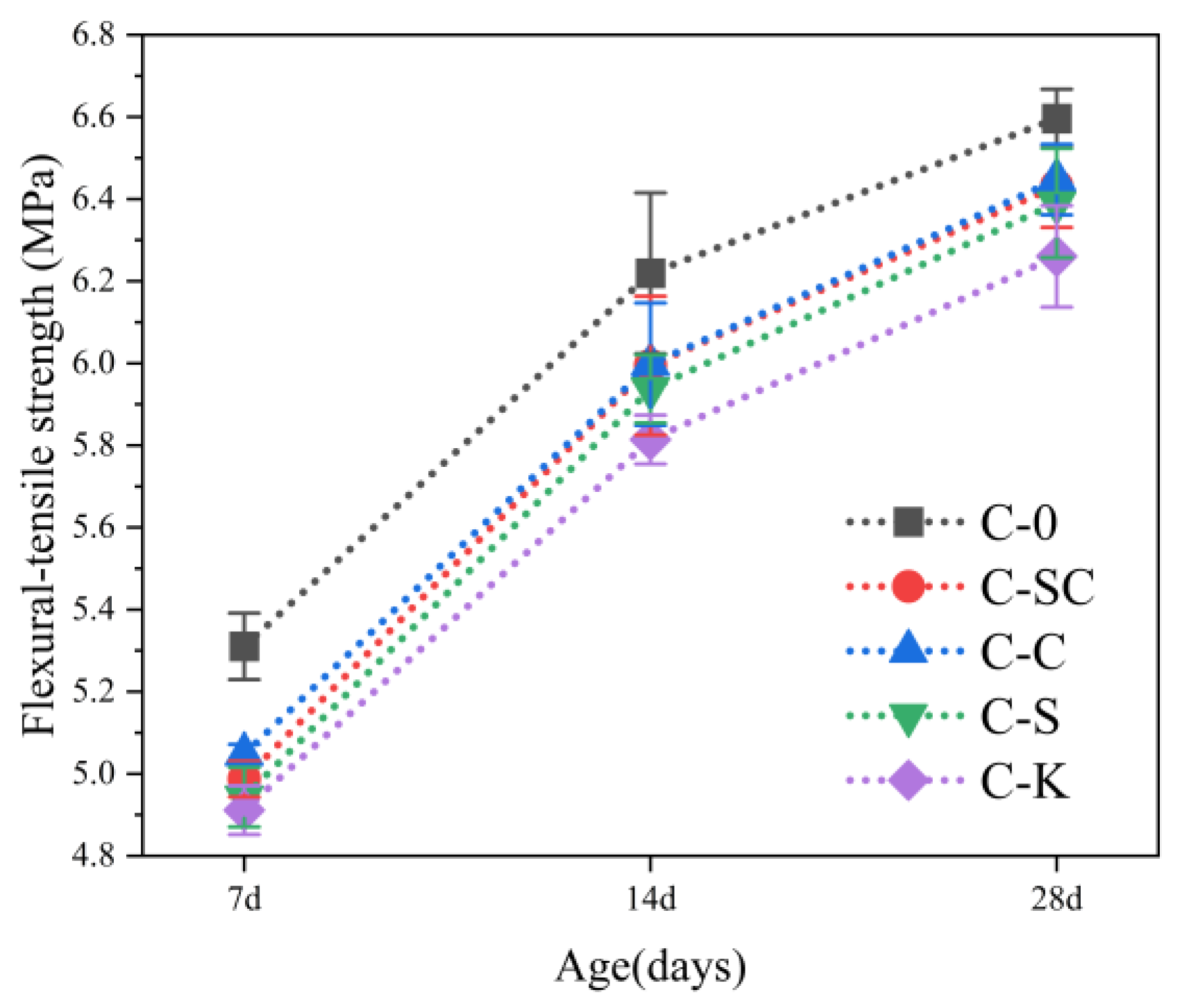
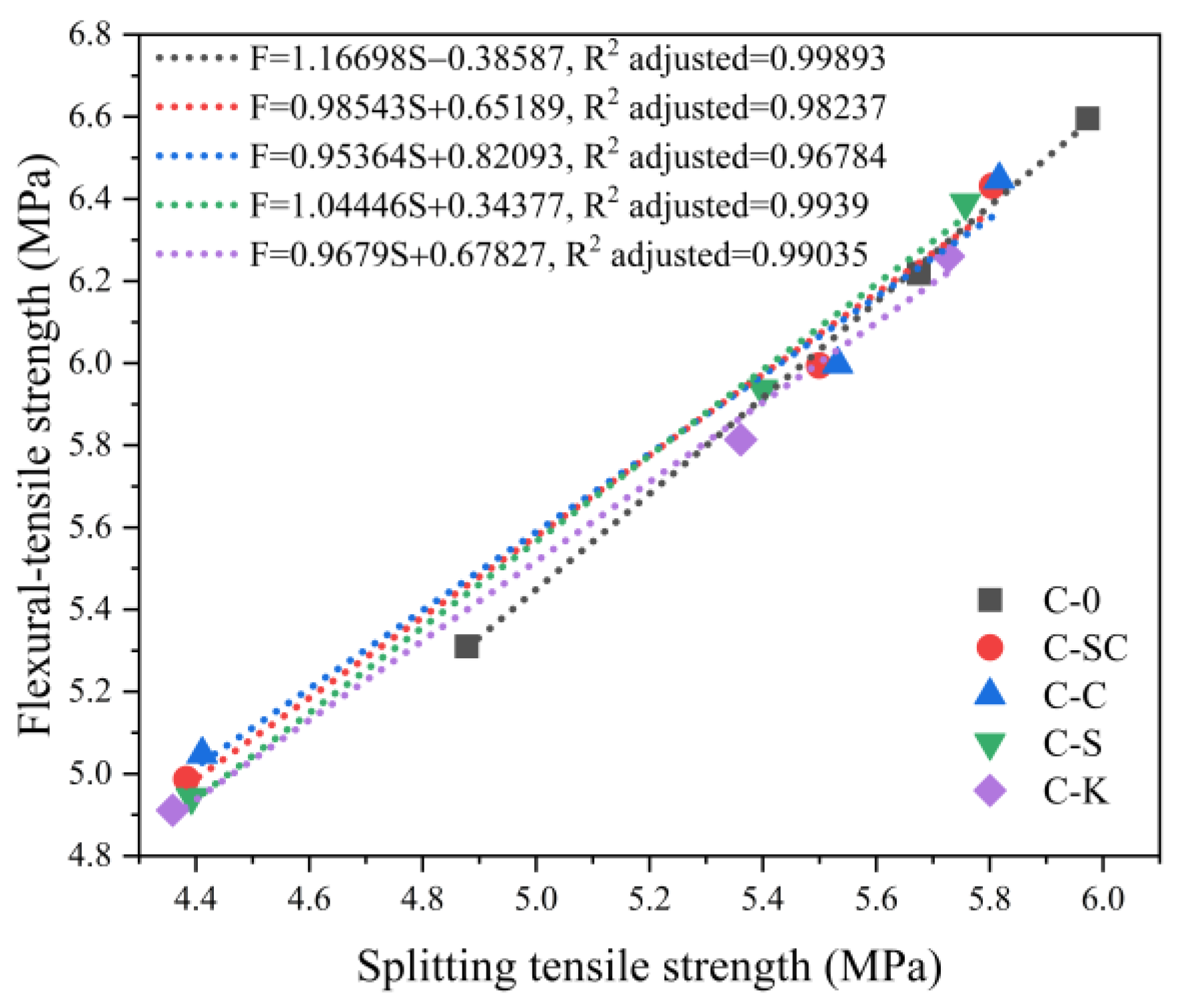


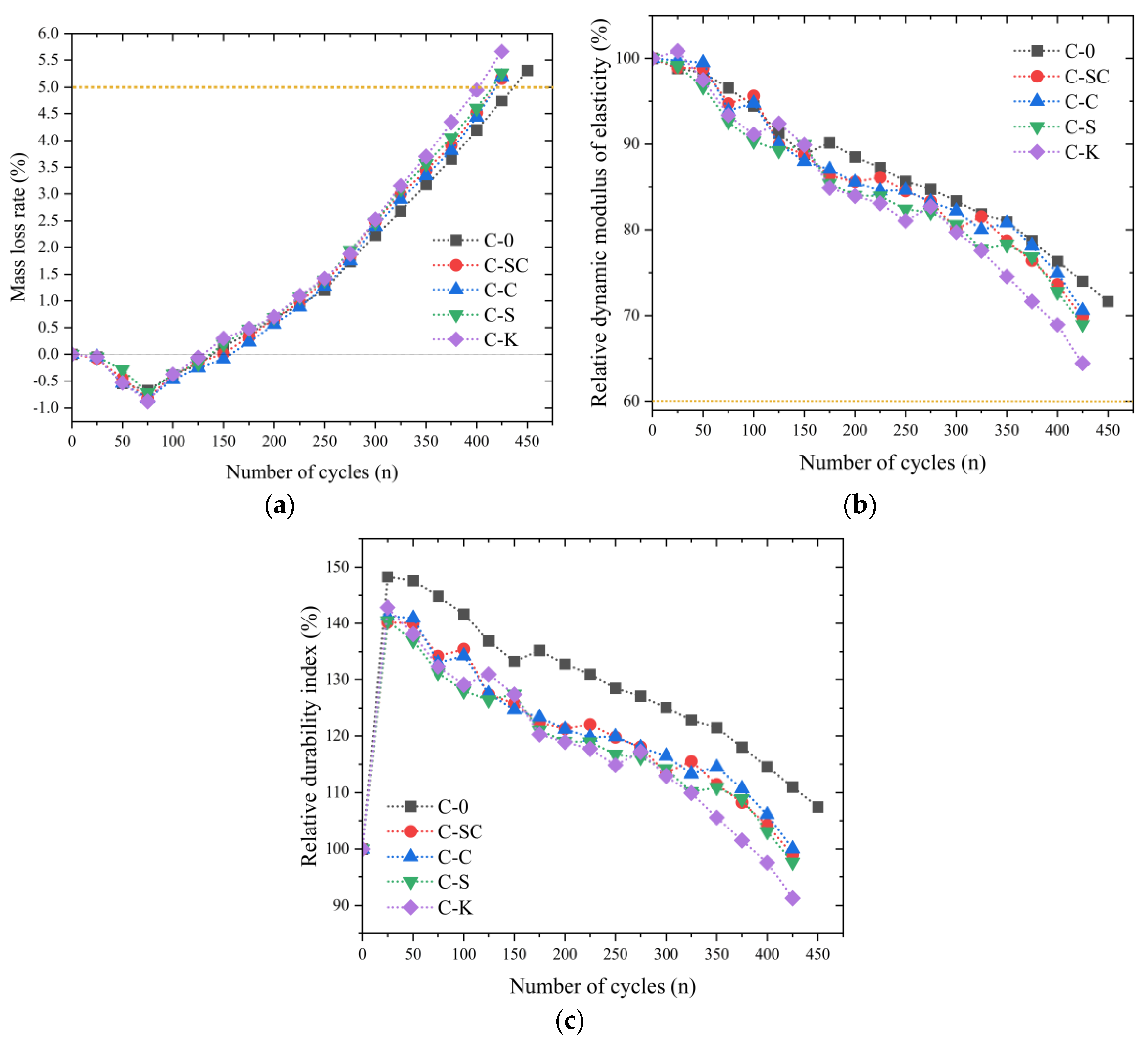
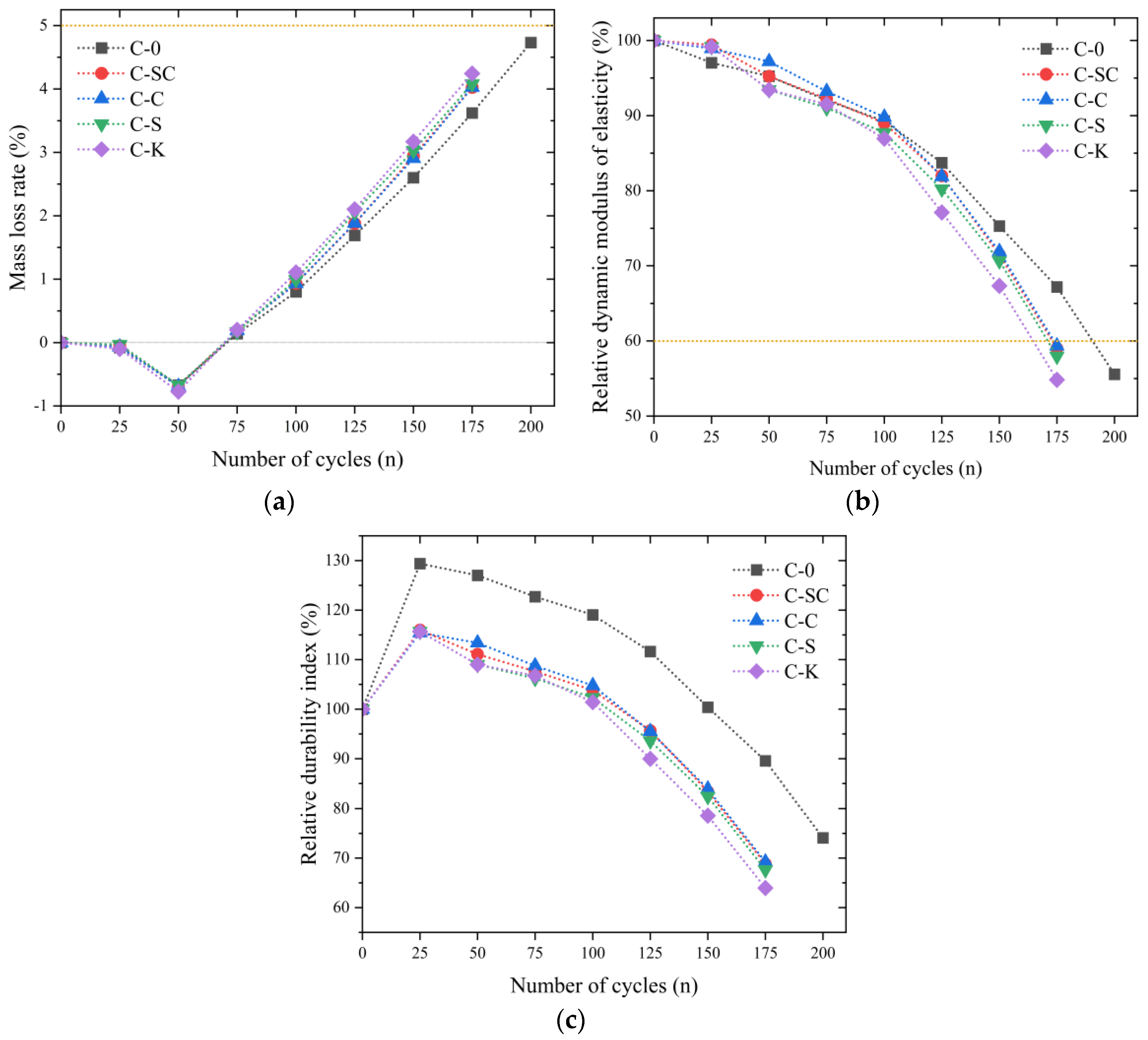
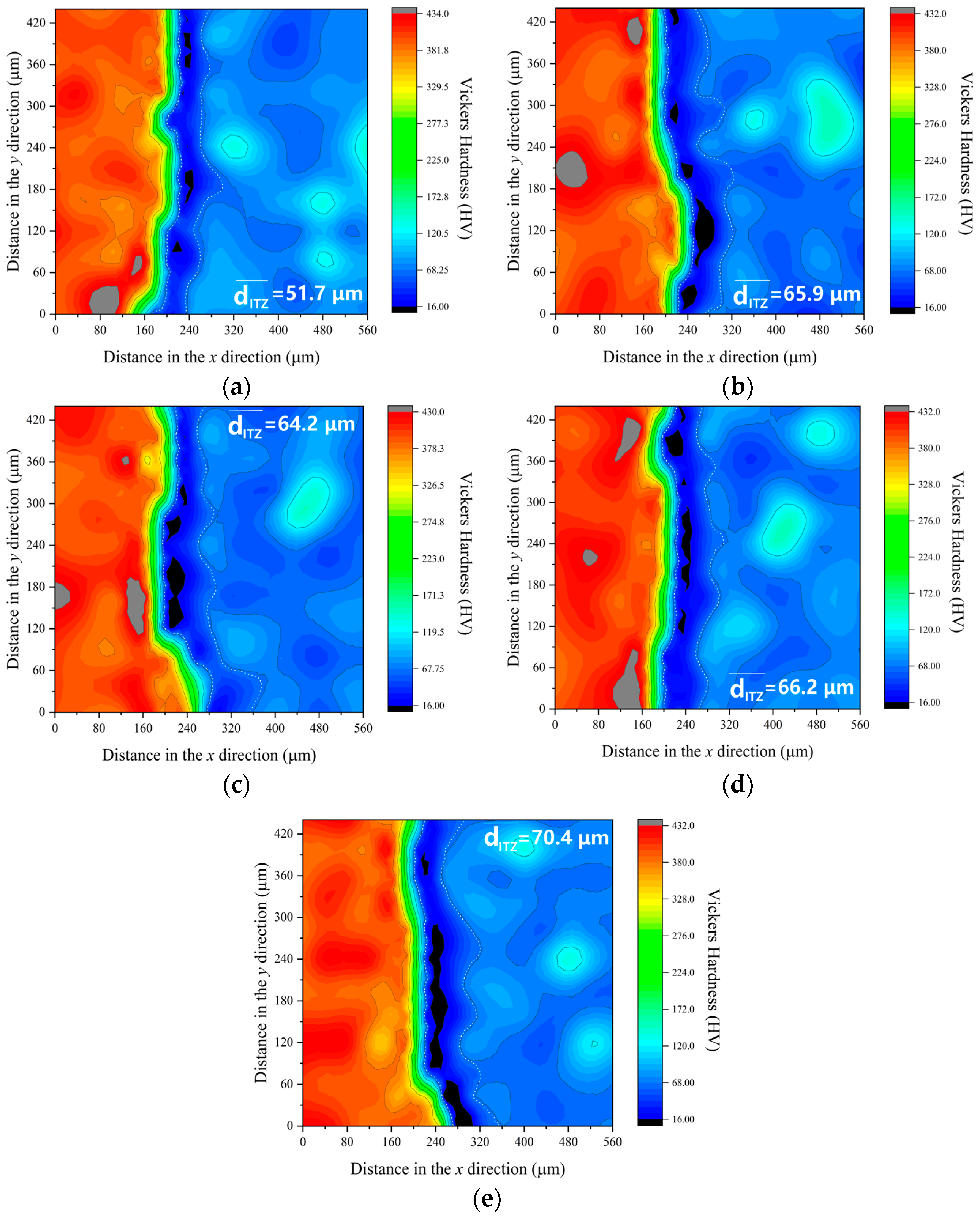
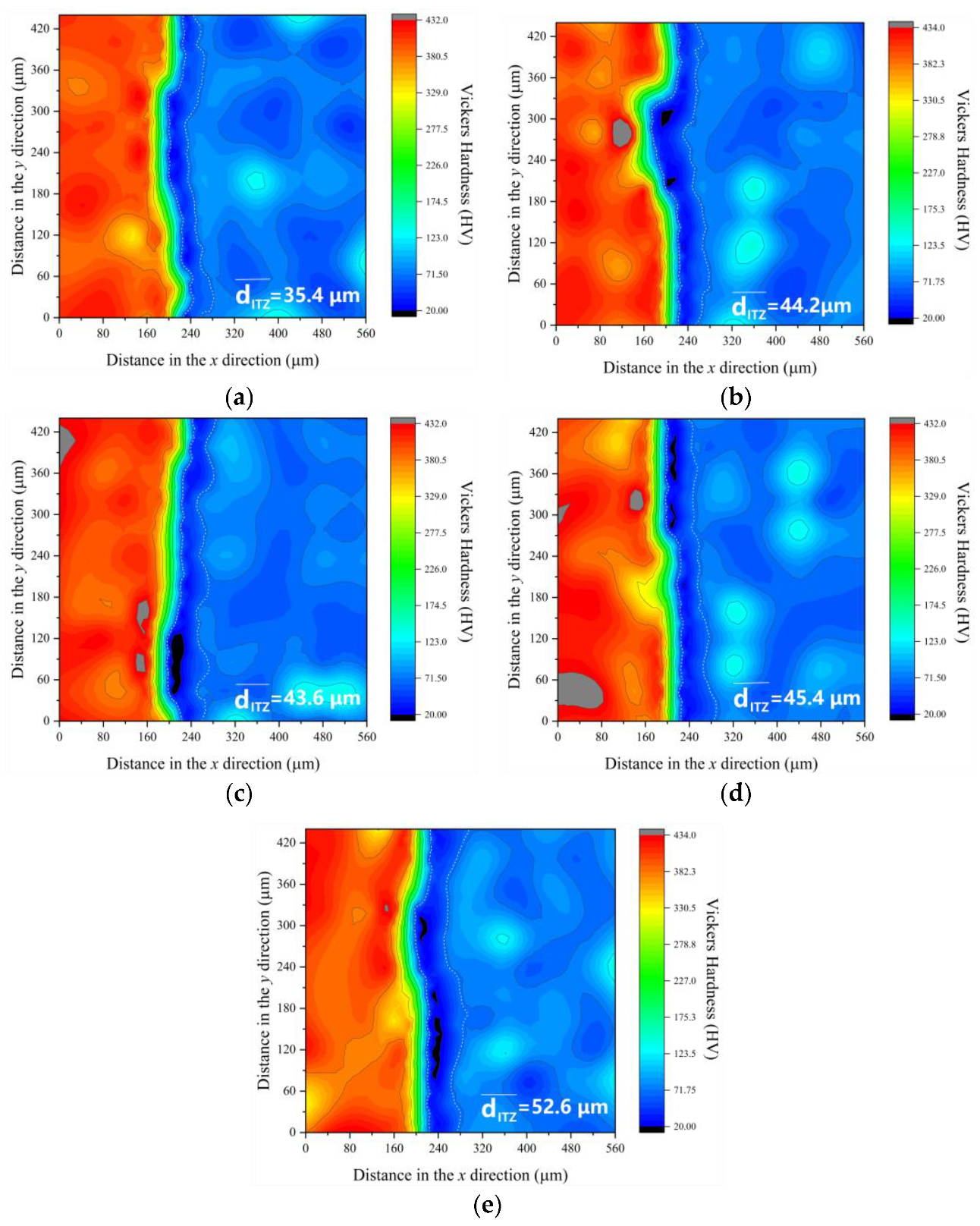
| Chemical Composition (wt.%) | Cement | Fly Ash | Physical Properties | Cement | Fly Ash |
|---|---|---|---|---|---|
| 21.571 | 62.219 | ) | 340 | 544 | |
| 4.957 | 20.203 | ) | 2.9 | 2.40 | |
| 4.909 | 2.915 | Initial setting time (min) | 185 | - | |
| 62.094 | 8.906 | Final setting time (min) | 250 | - | |
| 1.467 | 0.815 | 3d Flexural strength (MPa) | 6.7 | - | |
| 0.344 | 1.357 | 28d Flexural strength (MPa) | 9.4 | - | |
| 0.499 | 2.170 | 3d Compressive strength (MPa) | 27.9 | - | |
| 3.417 | 0.620 | 28d Compressive strength (MPa) | 60.8 | - | |
| Ignition loss | 2.3 | 3.1 | Activity index (28d) | - | 84% |
| Properties | ) | Clay Content (%) | Crush Value (%) | Fineness Modulus |
|---|---|---|---|---|
| Coarse aggregate | 2790 | 0.60 | 13.4 | - |
| River sands | 2630 | 1.35 | - | 2.9 |
| Diameter (m) | Length (mm) | Elastic Modulus (GPa) | Tensile Strength (MPa) | Elongation (%) |
|---|---|---|---|---|
| 20 | 6 | 4.5 | 530 | 22 |
| Group | Aggregates |
|---|---|
| C-0 | Washed aggregates |
| C-SC | Unwashed aggregates |
| C-C | Washed aggregates, re-incorporation of mud powder sieved from unwashed coarse aggregate with a particle size of less than 75 μm |
| C-S | Washed aggregates, re-incorporation of mud powder sieved from unwashed river sands with a particle size of less than 75 μm |
| C-K | Washed aggregates, re-incorporation of clay powder whose main ingredient is kaolin with a particle size of less than 75 μm |
| Chemical Composition (wt.%) | Mud Powder-C | Mud Powder-S | Mud Powder-K |
|---|---|---|---|
| 55.514 | 68.418 | 50.650 | |
| 18.562 | 16.567 | 47.511 | |
| 7.304 | 2.714 | 0.514 | |
| 7.447 | 2.487 | 0.154 | |
| 4.367 | 0.798 | 0.061 | |
| 2.921 | 3.971 | 0.066 | |
| 2.072 | 3.953 | 0.145 | |
| 0.116 | 0.125 | 0.024 | |
| 0.982 | 0.566 | 0.793 | |
| 0.317 | 0.199 | 0.032 |
| Sample | Mixture Proportion/) | ||||||||
|---|---|---|---|---|---|---|---|---|---|
| Cement | Fly Ash | Water | Stone | River Sand | PPF | SP (RAWY-101) | Inhibitor (SBT-TIA) | Clay | |
| C-0 | 416 | 74 | 156 | 1070 | 713 | 0.9 | 4.165 | 15 | 0 |
| C-SC | 416 | 74 | 156 | 1060.37 | 706.583 | 0.9 | 5.145 | 15 | 16.047 |
| C | 416 | 74 | 156 | 1053.953 | 713 | 0.9 | 5.145 | 15 | 16.047 |
| C-S | 416 | 74 | 156 | 1070 | 696.953 | 0.9 | 4.9 | 15 | 16.047 |
| C-K | 416 | 74 | 156 | 1060.37 | 706.583 | 0.9 | 5.39 | 15 | 16.047 |
| Group | Mass Loss Rate (%) | Relative Dynamic Elastic Modulus (%) | Relative Durability Index (%) | Maximum Number of Freeze–Thaw Cycles |
|---|---|---|---|---|
| C-0 | 5.31 | 71.66 | 107.49 | 450 |
| C-SC | 5.17 | 69.89 | 99.01 | 425 |
| C-C | 5.19 | 70.61 | 100.03 | 425 |
| C-S | 5.26 | 68.94 | 97.67 | 425 |
| C-K | 5.66 | 64.43 | 91.28 | 425 |
| Group | Mass Loss Rate (%) | Relative Dynamic Elastic Modulus (%) | Relative Durability Index (%) | Maximum Number of Freeze–Thaw Cycles |
|---|---|---|---|---|
| C-0 | 4.73 | 55.57 | 74.09 | 200 |
| C-SC | 4.02 | 58.99 | 68.83 | 175 |
| C-C | 4.03 | 59.34 | 69.23 | 175 |
| C-S | 4.08 | 57.97 | 67.63 | 175 |
| C-K | 4.24 | 54.84 | 63.97 | 175 |
Disclaimer/Publisher’s Note: The statements, opinions and data contained in all publications are solely those of the individual author(s) and contributor(s) and not of MDPI and/or the editor(s). MDPI and/or the editor(s) disclaim responsibility for any injury to people or property resulting from any ideas, methods, instructions or products referred to in the content. |
© 2023 by the authors. Licensee MDPI, Basel, Switzerland. This article is an open access article distributed under the terms and conditions of the Creative Commons Attribution (CC BY) license (https://creativecommons.org/licenses/by/4.0/).
Share and Cite
Shi, C.; Zhao, R.; Wang, W. Effect of Mud Powder on the Performance of Bridge Deck Leveling Concrete in a Seasonally Frozen Region. Materials 2023, 16, 6793. https://doi.org/10.3390/ma16206793
Shi C, Zhao R, Wang W. Effect of Mud Powder on the Performance of Bridge Deck Leveling Concrete in a Seasonally Frozen Region. Materials. 2023; 16(20):6793. https://doi.org/10.3390/ma16206793
Chicago/Turabian StyleShi, Chenglin, Ruize Zhao, and Wensheng Wang. 2023. "Effect of Mud Powder on the Performance of Bridge Deck Leveling Concrete in a Seasonally Frozen Region" Materials 16, no. 20: 6793. https://doi.org/10.3390/ma16206793
APA StyleShi, C., Zhao, R., & Wang, W. (2023). Effect of Mud Powder on the Performance of Bridge Deck Leveling Concrete in a Seasonally Frozen Region. Materials, 16(20), 6793. https://doi.org/10.3390/ma16206793







